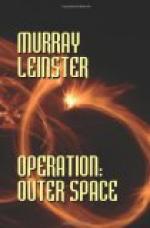In a sense, the Dabney field had an effect similar to the invention of railways. The same horsepower moved vastly more weight faster, over steel rails, than it could haul over a rutted dirt road. The same rocket-thrust moved more weight faster in the Dabney field than in normal space. There would be a practical limit to the speed at which a wagon could be drawn over a rough road. The speed of light was a limit to the speed of matter in normal space. But on a railway the practical speed at which a vehicle could travel went up from three miles an hour to a hundred and twenty. In the Dabney field it was yet to be discovered what the limiting velocity might be. But old formulas for acceleration and increase-of-mass-with-velocity simply did not apply in a Dabney field.
Jones rode back to Lunar City with Cochrane and Holden and Babs. His face was dead-pan.
Babs tried to recover the mien and manner of the perfect secretary.
“Mr. Cochrane,” she said professionally, “will you want to read the publicity releases Mr. Bell turns out from what Mr. West and Mr. Jamison tell him?”
“I don’t think it matters,” said Cochrane. “The newsmen will pump West and Jamison empty, anyhow. It’s all right. In fact, it’s better than our own releases would be. They’ll contradict each other. It’ll sound more authentic that way. We’re building up a customer-demand for information.”
The small moon-jeep rolled and bumped gently down the long, improbable highway back to Lunar City. Its engine ran smoothly, as steam-engines always do. It ran on seventy per cent hydrogen peroxide, first developed as a fuel back in the 1940s for the pumps of the V2 rockets that tried to win the Second World War for Germany. When hydrogen peroxide comes in contact with a catalyst, such as permanganate of potash, it breaks down into oxygen and water. But the water is in the form of high-pressure steam, which is used in engines. The jeep’s fuel supplied steam for power and its ashes were water to drink and oxygen to breathe. Steam ran all motorized vehicles on Luna.
“What are you thinking about, Jones?” asked Cochrane suddenly.
Jones said meditatively:
“I’m wondering what sort of field-strength a capacity-storage system would give me. I boosted the field intensity this time. The results were pretty good. I’m thinking—suppose I made the field with a strobe-light power-pack—or maybe a spot-welding unit. Even a portable strobe-light gives a couple of million watts for the forty-thousandth of a second. Suppose I fixed up a storage-pack to give me a field with a few billion watts in it? It might be practically like matter-transmission, though it would really be only high-speed travel. I think I’ve got to work on that idea a little ...”
Cochrane digested the information in silence.
“Far be it from me,” he said presently, “to discourage such high-level contemplation. Bill, what’s on your mind?”




